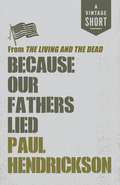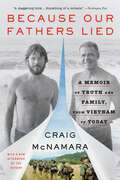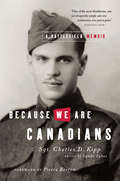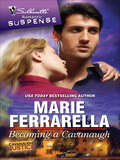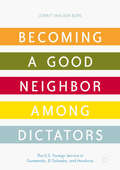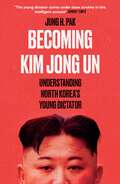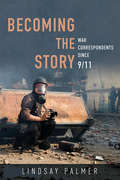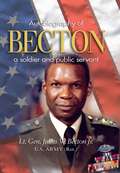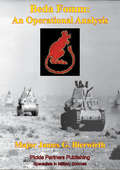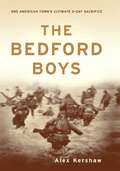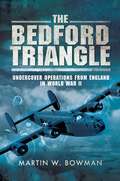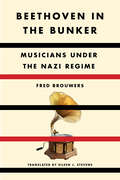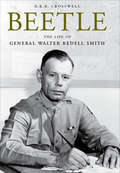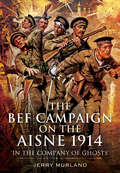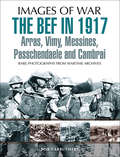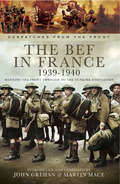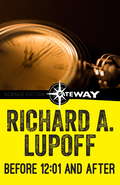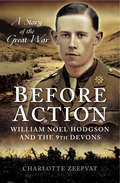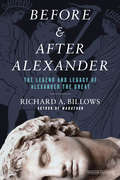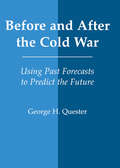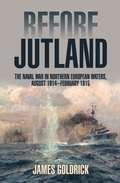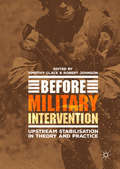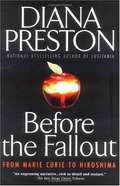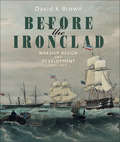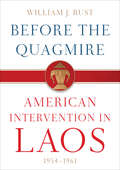- Table View
- List View
Because Our Fathers Lied: from The Living and the Dead
by Paul HendricksonRobert S. McNamara was the official face of Vietnam, the technocrat with steel-rimmed glasses and an ironclad faith in numbers who kept insisting that the war was winnable long after he had ceased to believe it was. In his insightful, morally devastating book, The Living and the Dead, Paul Hendrickson juxtaposes Robert S. McNamara's story with those of a wounded Marine, an Army nurse, a Vietnamese refugee, a Quaker who burned himself to death to protest the war, and an enraged artist who tried to kill the man he saw as the war's architect. This is the brilliant, emotional coda where, in meticulous yet compassionate prose, Hendrickson captures his chase after the story of the man and the haunted years of McNamara’s life after Vietnam. A Vintage Shorts Vietnam Selection. An ebook short.
Because Our Fathers Lied: A Memoir of Truth and Family, from Vietnam to Today
by Craig McNamaraThis unforgettable father and son story confronts the legacy of the Vietnam War across two generations: &“an important book that should be read by every American&” (Ron Kovic, Vietnam Veteran and author of Born on the Fourth of July). Craig McNamara came of age in the political tumult and upheaval of the late 60s. While Craig McNamara would grow up to take part in anti-war demonstrations, his father, Robert McNamara, served as John F. Kennedy's Secretary of Defense and the architect of the Vietnam War. This searching and revealing memoir offers an intimate picture of one father and son at pivotal periods in American history. Because Our Fathers Lied is more than a family story—it is a story about America. Before Robert McNamara joined Kennedy's cabinet, he was an executive who helped turn around Ford Motor Company. Known for his tremendous competence and professionalism, McNamara came to symbolize "the best and the brightest." Craig, his youngest child and only son, struggled in his father's shadow. When he ultimately fails his draft board physical, Craig decides to travel by motorcycle across Central and South America, learning more about the art of agriculture and making what he defines as an honest living. By the book's conclusion, Craig McNamara is farming walnuts in Northern California and coming to terms with his father's legacy. Because Our Fathers Lied tells the story of the war from the perspective of a single, unforgettable American family.
Because We Are Canadians: A Battlefield Memoir
by Charles KippThis is the story of one man's war--the memoirs of Sgt. Charles D. Kipp, who served with the Canadian army on active duty in Europe during the bloody days and weeks following D-Day. What makes this work stand out from other Second World War battlefield journals is its unadorned, almost naive sense--a guileless attention to small details, horrific and beautiful, that Kipp recalls from his experiences. First published in 2003, this is a must-read, not only for veterans of the War and military history buffs, but also for anyone who seeks to understand what ordinary soldiers endured during the Second World War. Charles d. Kipp was wounded nine times during ten months of fighting at the front during the Second World War. After the war, he farmed briefly before being diagnosed with post-traumatic stress syndrome and suffering a second heart attack. He passed away in January 2000.
Becoming a Cavanaugh (Cavanaugh Justice #15)
by Marie FerrarellaSomeone was murdering the city's elite, and anyone could be next. Assigned to the case was Detective Kyle O'Brien, whose new partner was the blond, blue-eyed Jaren Rosetti, as sunny as Kyle was dark. Not to mention too irresistible for her own good. But their growing attraction had to be pushed aside as the horrific killer swept through the urban landscape. Kyle knew he was falling hard for his obstinate partner, who had a will of her own. While they deciphered the psychopath's code, the killer prepared to strike again—this time dangerously close to home.
Becoming a Good Neighbor among Dictators: The U.S. Foreign Service in Guatemala, El Salvador, and Honduras
by Jorrit van den BerkVery few works of history, if any, delve into the daily interactions of U. S. Foreign Service members in Latin America during the era of Roosevelt's Good Neighbor Policy. But as Jorrit van den Berk argues, the encounters between these rank-and-file diplomats and local officials reveal the complexities, procedures, intrigues, and shifting alliances that characterized the precarious balance of U. S. foreign relations with right-wing dictatorial regimes. Using accounts from twenty-two ministers and ambassadors, Becoming a Good Neighbor among Dictators is a careful, sophisticated account of how the U. S. Foreign Service implemented ever-changing State Department directives from the 1930s through the Second World War and early Cold War, and in so doing, transformed the U. S. -Central American relationship. How did Foreign Service officers translate broad policy guidelines into local realities? Could the U. S. fight dictatorships in Europe while simultaneously collaborating with dictators in Guatemala, El Salvador, and Honduras? What role did diplomats play in the standoff between democratic and authoritarian forces? In investigating these questions, Van den Berk draws new conclusions about the political culture of the Foreign Service, its position between Washington policymakers and local actors, and the consequences of foreign intervention.
Becoming Kim Jong Un: Understanding North Korea’s Young Dictator
by Jung H. Pak&‘The young dictator comes under close scrutiny in this intelligent account' Sunday Times The mysterious, brutal, and calculating Kim Jong Un has risen to become the unchallenged dictator of a nuclear rogue state. He now possesses weaponry capable of threatening America and its allies, and his actions have already significantly changed global politics. It&’s believed that Kim Jong Un is in his thirties, only a few years into what will likely be decades of leadership. He is in the news almost every day, and yet we still know almost nothing about him and how he became the supreme leader of the hermit kingdom. Former CIA analyst and North Korea expert Jung H. Pak reveals the explosive story of Kim Jong Il&’s third son: the spoilt and impetuous child, the mediocre student, the ruthless murderer, the shrewd grand strategist.
Becoming the Story: War Correspondents since 9/11
by Lindsay PalmerThe September 11 attacks produced changes in journalism and the lives of the people who practiced it. Foreign reporters felt surrounded by the hate of American colleagues for "the enemy." Americans in combat areas became literal targets of anti-U.S. sentiment. Behind the lines, editors and bureau chiefs scrambled to reorient priorities while feeling the pressure of sending others into danger. Becoming the Story examines the transformation of war reporting in the decade after 9/11. Lindsay Palmer delves into times when print or television correspondents themselves received intense public scrutiny because of an incident associated with the work of war reporting. Such instances include Daniel Pearl's kidnapping and murder; Bob Woodruff's near-fatal injury in Iraq; the expulsions of Maziar Bahari and Nazila Fathi from Iran in 2009; the sexual assault of Lara Logan; and Marie Colvin's 2012 death in Syria. Merging analysis with in-depth interviews of Woodruff and others, Palmer shows what these events say about how post-9/11 conflicts transformed the day-to-day labor of reporting. But they also illuminate how journalists' work became entangled with issues ranging from digitization processes to unprecedented hostility from all sides to the political logic of the War on Terror.
Becton
by Julius Becton Jr.This autobiography, published in cooperation with the Association of the United States Army (AUSA), highlights Lt. Gen. Becton's remarkable career and reveals the influences that contributed to his success. Becton's autobiography reflects on his youth in the suburban Philadelphia area, his parental and family influences, and his almost forty years of service in the U.S. Army and in subsequent civilian appointments. His devotion to leadership, education, service, race, and his spiritual upbringing are all central themes in the book.After finishing high school, Becton entered a segregated Army at age eighteen and over nearly forty years rose to the rank of lieutenant general. Two years after enlisting in the Army Air Corps Enlisted Reserve, he was commissioned a second lieutenant of infantry and subsequently fought with distinction in the Korean War. Integrated into the Regular Army in 1951, he went on to earn undergraduate and graduate degrees in mathematics and economics and held combat commands in the 101st Airborne Division in Vietnam. He commanded the legendary 1st Cavalry Division in 1975-76. Promoted to lieutenant general in 1978, he served as commanding general of the U.S. VII Corps in Germany and deputy commander of Training and Doctrine Command and the Army Inspector of Training before retiring in 1983.Following retirement he entered fields of international disaster assistance, emergency management, and education. Becton joined the Reagan administration in 1984 as Director of the Office of Foreign Disaster Assistance for the Agency for International Development. From 1985 to 1989 he was Director of the Federal Emergency Management Agency. Over the next six years, he was the COO of American Coastal Industries and president of Prairie View A&M University. His final civilian post was as CEO/Superintendent of public schools in the District of Columbia.Becton was listed several times by Ebony magazine as 'One of the 100 Most Influential Blacks in America.' In 2007 he was selected to receive the George Catlett Marshall Medal, the highest award presented by the Association of the U.S. Army (AUSA) for being a 'soldier, combat commander, administrator, educator, public servant, government leader, and role model.'
Beda Fomm: An Operational Analysis [Illustrated Edition]
by Major James G. BierwirthIncludes the War in North Africa Illustration Pack - 112 photos/illustrations and 21 maps.This study analyzes the Army's doctrinal definition of the battlefield framework through examination of British operations against the Italians in North Africa during the period, June 1940 through February 1941. This example illustrates how commanders can consider the battlefield framework in organizing combat power. The study examines how commanders at the tactical and operational levels of war use the concepts of area of operations, battle space, and battlefield organization. This study also shows why tactical and operational commanders must consider each other's battlefield framework. It shows how actions in one commander's framework affects the other's. This study analyzes, through the battlefield framework, General Wavell's actions as the operational commander and their effects on the tactical commander, Lieutenant General O'Connor. Additionally, the study analyzes Lieutenant General O'Connor's battlefield framework and how actions at the tactical level created opportunities for the operational commander.
The Bedford Boys: One American Town's Ultimate D-day Sacrifice
by Alex KershawJune 6, 1944: Nineteen boys from Bedford, Virginia--population just 3,000 in 1944--died in the first bloody minutes of D-Day. They were part of Company A of the 116th Regiment of the 29th Division, and the first wave of American soldiers to hit the beaches in Normandy. Later in the campaign, three more boys from this small Virginia town died of gunshot wounds. Twenty-two sons of Bedford lost--it is a story one cannot easily forget and one that the families of Bedford will never forget. The Bedford Boys is the true and intimate story of these men and the friends and families they left behind.Based on extensive interviews with survivors and relatives, as well as diaries and letters, Kershaw's book focuses on several remarkable individuals and families to tell one of the most poignant stories of World War II--the story of one small American town that went to war and died on Omaha Beach.
The Bedford Triangle: Undercover Operations from England in World War II
by Martin W. BowmanFollow secret operations behind enemy lines in WWII.The Bedford Triangle portrays the crucial part played by the British Special Operations Executive, the US Army Air Force and the American Office of Strategic Services in operations behind enemy lines in occupied Europe during the Second World War. Milton Ernest Hall, a country house in Bedfordshire used officially as the UK headquarters of the US Army Air Force Service Command, was located at the heart of a network of top secret Allied Radio and propaganda transmitting stations, political warfare units and undercover British and American formations dealing in espionage and subterfuge.Martin Bowman draws upon revealing first-hand accounts, together with official documentary evidence, to provide tantalizing glimpses of cloak and dagger operations. The author's extensive research has revealed that Allied Secret Service organizations participated in even more unorthodox activities, such as clandestine propaganda and political warfare. He also reveals the truth about what really happened to legendary band leader Glenn Miller.Skyhorse Publishing, as well as our Arcade imprint, are proud to publish a broad range of books for readers interested in history--books about World War II, the Third Reich, Hitler and his henchmen, the JFK assassination, conspiracies, the American Civil War, the American Revolution, gladiators, Vikings, ancient Rome, medieval times, the old West, and much more. While not every title we publish becomes a New York Times bestseller or a national bestseller, we are committed to books on subjects that are sometimes overlooked and to authors whose work might not otherwise find a home.
Beethoven in the Bunker: Musicians Under the Nazi Regime
by Fred BrouwersThis compelling survey examines the remarkable relationship between the Nazis and classical music through the stories of musicians, composers, and conductors across the political spectrum.May 1945. A Soviet military patrol searches Hitler&’s secret bunker in Berlin. They find bodies, documents, jewelry, paintings—and also an extensive collection of 78 rpm records. It comes as no surprise that this collection includes work by Beethoven, Wagner, and Bruckner. The same goes for a procession of other giants promoted by the Nazi regime: &“It seems as if the Nazis put a steel helmet on Mozart, girded Schubert with a saber, and wrapped barbed wire around Johann Strauss&’s neck,&” composer Robert Stolz once said. But how is it possible that Hitler&’s favorites also included &“forbidden&” Jewish and Russian composers and performers? While Hitler sat secretly enjoying previously recorded music in his bunker, musicians made of flesh and blood were denied a means of making a living. They died in concentration camps or in other war-related circumstances. They survived but ended up in psychiatric care; they managed to flee just in time; they sided with the regime—out of conviction or coercion—or they joined the resistance. From fiery conductor Arturo Toscanini, who defied Mussolini and Hitler, to opportunistic composer Richard Strauss and antisemitic pianist Elly Ney, who collaborated with the Third Reich to varying extents and for different reasons, Fred Brouwers profiles the complex figures of this extraordinarily fascinating chapter in music history.
Beetle: The Life of General Walter Bedell Smith (American Warriors Series)
by D.K.R. CrosswellA valued adviser and trusted insider in the highest echelon of U.S. military and political leaders, General Walter Bedell Smith began his public service career of more than forty years at age sixteen, when he joined the Indiana National Guard. His bulldog tenacity earned him an opportunity to work with General George C. Marshall in 1941, playing an essential role in forming the offices of the Combined and Joint Chiefs of Staff; and after his appointment as chief of staff to Dwight D. Eisenhower in 1942, Smith took a central part in planning and orchestrating the major Allied operations of World War II in Europe. Among his many duties, Smith negotiated and signed the surrenders of the Italian and German armed forces on May 7, 1945. Smith's postwar career included service as the U.S. ambassador to the Soviet Union, director of the Central Intelligence Agency, and undersecretary of state. Despite his contributions to twentieth-century American military and diplomatic history, the life and work of Smith have largely gone unappreciated. In Beetle:The Life of General Walter Bedell Smith, D. K. R. Crosswell offers the first full-length biography of the general, including insights into his close relationships with Marshall and Eisenhower. Meticulously researched and long overdue, Beetle sheds new light on Eisenhower as supreme commander and the campaigns in North Africa, Italy, and Europe . Beetle is the fascinating history of a soldier, diplomat, and intelligence chief who played a central role in many decisions that altered mid-twentieth-century American history.
The BEF Campaign on the Aisne 1914: 'In the Company of Ghosts'
by Jerry MurlandThe river Aisne featured prominently in August 1914 during the Retreat from Mons and in September was the scene of bitter fighting when the BEF re-crossed it in their unsuccessful attempt to dislodge the German Army entrenched along the Northern Crest.The fighting was hugely costly to the BEF, which had already fought three major engagements and marched over 200 miles in a month. The three British Corps lost over 700 officers and some 15,000 men. Little wonder one officer wrote that he felt he was in the company of ghosts.Historian Jerry Murland places the Aisne battles in their context, both from the BEF and German viewpoints. He highlights the early deficiencies and unpreparedness of the British Army staff and logistics organization as well as friction among the command structure, all of which hampered effective operations.
The BEF in 1917: Arras, Vimy, Messines, Passchendaele and Cambrai (Images of War)
by Bob CarruthersThis new volume in the long-running Images of War series features the actions of the British Army at Passchendaele. The book is comprised of rare photographs illustrating the years of fighting on the northern sector of the Ypres salient, which finally culminated in the capture of the ridge at Passchendaele, accompanied by a powerful text written by Official War Correspondent Philip Gibbs, who was an eyewitness to the events. Photographs from the battlefield illustrate the terrible conditions, which the British forces on the battlefield endured in the notorious engagement, which has become synonymous with mud and squalor.This book incorporates a wide range of images, encompassing the actions of the British infantry and their supporting artillery. Also featured are images which depict the almost incomprehensible state of the waterlogged trenches. Portraits of the British troops are contrasted with German prisoners of war and the endless battle to get the supply columns through to the front.
The BEF in France, 1939–1940: Manning the Front Through to the Dunkirk Evacuation (Despatches From The Front Ser.)
by Martin Mace John GrehanThe British Expeditionary Force (BEF) was the British force in Europe from 19391940 during the Second World War. Commanded by General Lord Gort, the BEF constituted one-tenth of the defending Allied force.The British Expeditionary Force was started in 1938 in readiness for a perceived threat of war after Germany annexed Austria in March 1938 and the claims on the Sudetenland, which led to the invasion of Czechoslovakia in March 1939. After the French and British had promised to defend Poland, the German invasion of that country began and war was declared on 3 September 1939.The BEF was sent to France in September 1939 and deployed mainly along the BelgianFrench border during the so-called Phoney War leading up to May 1940. The BEF did not commence hostilities until the invasion of France on 10 May 1940. After the commencement of battle, they were driven back through Belgium and north-western France, forcing their eventual evacuation from several ports along the French northern coastline in Operations Dynamo, Ariel and Cycle. The most notable evacuation was from the Dunkirk region and from this the phrase Dunkirk Spirit was coined.
Before 12:01 and After
by Richard A. LupoffBefore 12:01 and After is a collection of science fiction, fantasy, mystery and horror stories by Richard A. Lupoff, collecting the best of his short fiction from his long writing career. It contains the following stories:"Mr. Greene and the Monster""BOOM!""Incident in the 14th St. BMT""After the Dreamtime""12:01 P.M.""Venus-Ah, Venus!""With the Evening News""Saltzman's Madness""God of the Naked Unicorn""Nebogipfel at the End of Time""Mort in Bed""Stroka Prospekt""Two Sort-Of Adventures""Blinky Henderson Again""The Digital Wristwatch of Philip K. Dick""Snow Ghosts""Triptych""The House on Rue Chartres""The Doom That Came to Dunwich""The Woodstock West Killer""Easy Living""Dogwalker""A Funny Thing Happened..."
Before Action: William Noel Hodgdon and the 9th Devons, A Story of the Great War
by Charlotte ZeepvatWilliam Noel Hodgson never intended to be a soldier; he wanted to write. The Great War made his reputation as a poet but it also killed him. This groundbreaking biography traces his path through the pre-war world and explores why he set his own hopes and plans aside to join the army. His story is personal but it evokes the experience of a generation.A hundred years on, Hodgson is not only remembered for his poetry. He has become one of the best-known casualties of the first day of the Battle of the Somme, the most deadly day in British military history. His own unit, the 9th Battalion, The Devonshire Regiment, lost well over half the men who went over the top that morning and every officer but one: dead, wounded or missing, most in the first half-hour.Before Action draws on Hodgsons own writing and on the unpublished letters and diaries of his fellow officers to recreate the experiences of a 1914 volunteer battalion. Through their eyes we see everything from the lighter moments of soldiering to battle at its most violent: at Loos, where Hodgson won the Military Cross, and the opening day of the Somme offensive. The book offers an important new explanation of what happened to the 9th Devons that fateful morning. It uncovers the hidden meanings behind some of Hodgsons most familiar poems, and its wider themes of family and friendship, war, grief and remembrance, are universal.
Before and After Alexander: The Legend And Legacy Of Alexander The Great
by Richard A. BillowsBy the author of Marathon, an enlightening look at the historical context behind Alexander the Great, his accomplishments, and his legacy In the arc of western history, Ancient Greece is at the apex, owing to its grandeur, its culture, and an intellectual renaissance to rival that of Europe. So important is Greece to history that figures such as Plato and Socrates are still household names, and the works of Homer are regularly adapted into movies. The most acclaimed hero of all, though, is Alexander the Great. While historians have studied Alexander’s achievements at length, author and professor Richard A. Billows delves deeper into the obscure periods of Alexander’s life before and after his reign. In the definitive Before and After Alexander, Billows explores the years preceding Alexander, who, Billows argues, without the foundation laid by his father, Philip II of Macedon. would not have had the resources or influence to develop one of the greatest empires in history. Alexander was groomed from a young age to succeed his father, and by the time Philip was assassinated in 336 BC, his great empire was already well underway. The years following Alexander's death were even more momentous. In this ambitious new work, Richard Billows robustly challenges the notion that the political strife that followed was for lack of a leader as competent as Alexander, pointing out instead that there were too many extremely capable leaders who exploited the power vacuum created by Alexander's death to carve out kingdoms for themselves. Above all, in Before and After Alexander, Billows eloquently and convincingly posits a complex view of one of the greatest empires in history, framing it not as the achievement of one man, but the culmination of several generations of aggressive expansion toward a unified purpose.
Before and After the Cold War: Using Past Forecasts to Predict the Future
by George H. QuesterThe end of the Cold War came as good news for most of the world. No one had predicted the collapse of Communist rule for several decades. This book looks at how political scientists failed to predict such a quick resolution and ways in which the world might develop post Cold War.
Before Jutland
by James GoldrickBefore Jutland is an effort to understand what happened at sea in northern European waters in 1914-15 when the German High Sea Fleet faced the Grand Fleet in the North Sea and the Russian Fleet in the Baltic. The book is an extensively revised and extended version of the author’s 1984 work The King’s Ships Were at Sea. It covers the first six months of the First World War because very important things occurred in that time and, despite the loose ends that inevitably remain with four more years of conflict to follow, important things can be said. The focus is primarily on the British, but both the Germans and the Russians are integral to the study because neither the British nor the Germans’ North Sea activities can be fairly assessed without giving due weight to the Baltic theatre of operations. This is an operational history, which balances coverage of the major incidents with treatment of the continuum of activity. The intent within the scene setting chapters is not to attempt a complete survey of the events of the previous decade, but to situate each navy within the environment of 1914. Before Jutland includes the battles of Heligoland Bight and the Dogger Bank, as well as the shock of the submarine and its effect on the operations of all the protagonists. In analyzing these events, it seeks to provide the context within which the protagonists were actually working, without the application of excessive hindsight, because in 1914 so much was new and experimental. Observers are inclined to consider what is known as the 'Fisher Era’ as a continuum from Admiral Fisher’s accession as First Sea Lord in the British Admiralty in 1904; in reality the pace of operational development not only accelerated but became truly multi-lane only after about 1909, just before the great reformer went into his first retirement. The pressures at all levels within navies were therefore intensifying in the years immediately before the outbreak of the war in ways that were not fully understood, nor necessarily recognized. In short, those involved were struggling to learn a new language of naval operations and warfare with an incomplete dictionary and very little grammar. In all, Before Jutland tries to show not only what happened, but how the services evolved to meet the challenges that they faced at the opening of the Great War and whether or not that evolution was successful.
Before Military Intervention: Upstream Stabilisation In Theory And Practice
by Robert Johnson Timothy ClackThis book explores the natures of recent stabilisation efforts and global upstream threats. As prevention is always cheaper than the crisis of state collapse or civil war, the future character of conflict will increasingly involve upstream stabilisation operations. However, the unpredictability and variability of state instability requires governments and militaries to adopt a diversity of approach, conceptualisation and vocabulary. Offering perspectives from theory and practice, the chapters in this collection provide crucial insight into military roles and capabilities, opportunities, risks and limitations, doctrine, strategy and tactics, and measures of effect relevant to operations in upstream environments. This volume will appeal to researchers and practitioners seeking to understand historical and current conflict.
Before the Fallout: From Marie Curie to Hiroshima
by Diana PrestonPreston describes the development of nuclear weapons, beginning with Marie Curie's work with radioactivity at the turn of the twentieth century and discussing the advances of subsequent scientists like Rutherford, Bohr, Einstein, and Oppenheimer. She traces how scientific discoveries were transformed into the atomic weapon first used on Hiroshima. Preston is the author of other books, including Lusitania: An Epic Tragedy.
Before the Ironclad: Warship Design and Development, 1815–1860
by David K. BrownIn the massive revolution that affected warship design between Waterloo and the Warrior, the Royal Navy was traditionally depicted as fiercely resisting every change until it was almost too late, but these old assumptions were first challenged in this authoritative history of the transition from sail to steam. Originally published in 1990, it began a process of revaluation which has produced a more positive assessment of the British contribution to the naval developments of the period. This classic work is here reprinted in an entirely new edition, with more extensive illustration.Beginning with the structural innovations of Robert Seppings, the book traces the gradual introduction of more scientific methods and the advent of steam and the paddle fighting ship, iron hulls and screw propulsion. It analyses the performance of the fleet in the war with Russia (18531856), and concludes with the design of the Warrior, the first iron-hulled, seagoing capital ship in the world. The author presents a picture of an organisation that was well aware of new technology, carefully evaluating its practical advantage, and occasionally (as with its enthusiastic espousal of iron hulls) moving too quickly for the good of the service. Written by an eminent naval architect, Before the Ironclad is both a balanced account of general developments, and an in-depth study of the ships themselves.
Before the Quagmire: American Intervention in Laos, 1954–1961
by William J. RustIn the decade preceding the first U.S. combat operations in Vietnam, the Eisenhower administration sought to defeat a communist-led insurgency in neighboring Laos. Although U.S. foreign policy in the 1950s focused primarily on threats posed by the Soviet Union and the People's Republic of China, the American engagement in Laos evolved from a small cold war skirmish into a superpower confrontation near the end of President Eisenhower's second term. Ultimately, the American experience in Laos foreshadowed many of the mistakes made by the United States in Vietnam in the 1960s.In Before the Quagmire: American Intervention in Laos, 1954--1961, William J. Rust delves into key policy decisions made in Washington and their implementation in Laos, which became first steps on the path to the wider war in Southeast Asia. Drawing on previously untapped archival sources, Before the Quagmire documents how ineffective and sometimes self-defeating assistance to Laotian anticommunist elites reflected fundamental misunderstandings about the country's politics, history, and culture. The American goal of preventing a communist takeover in Laos was further hindered by divisions among Western allies and U.S. officials themselves, who at one point provided aid to both the Royal Lao Government and to a Laotian general who plotted to overthrow it. Before the Quagmire is a vivid analysis of a critical period of cold war history, filling a gap in our understanding of U.S. policy toward Southeast Asia and America's entry into the Vietnam War.
